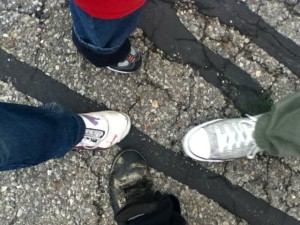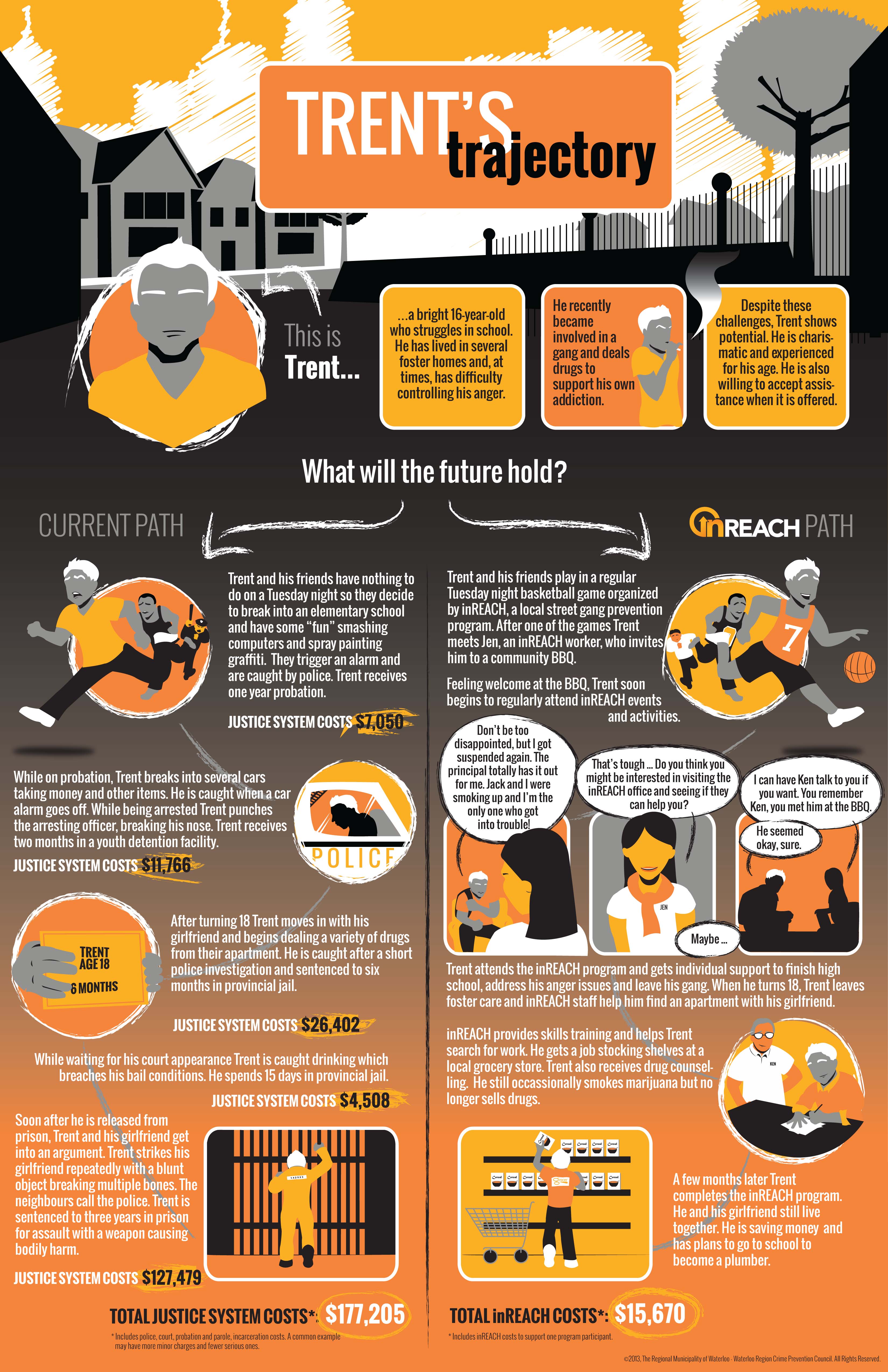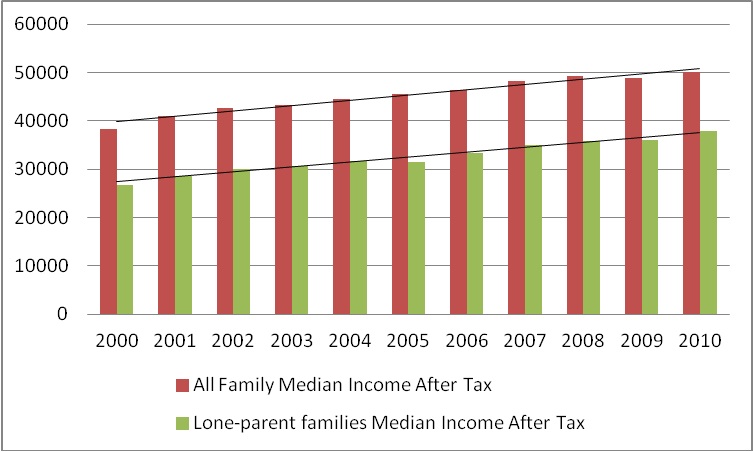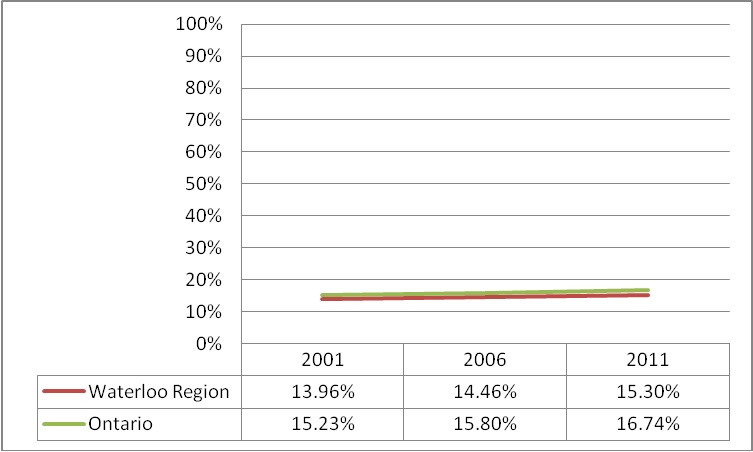Posts Tagged ‘youth’
Posted on: March 27th, 2014 by Waterloo Region Crime Prevention Council
I agree with the sayings – ‘there’s always more to learn’ and ‘it’s never too late to learn.’
I lived this out when I returned to university for a Masters degree the same year my daughter started university. Luckily she wasn’t too embarrassed to be at school with her mom. My timing turned out to be perfect for another reason as well. During my time in school I had the amazing opportunity to be involved with the research and evaluation of the innovative and highly successful gang prevention project, inREACH. I can guarantee you; I learned something new every day.
An excellent summary of the evaluation report for inREACH highlights a LOT of really important learning and accomplishments as a result of this collective community effort over the past few years. Sharing our story: Lessons learned from the inREACH experience describes how the project was implemented, the young people it served in the treatment and prevention programs, and the many positive impacts of the project on young people, neighbourhoods, organizations and the community as a whole.
 The most important lessons and understandings learned from inREACH will inspire community action toward a future where all young people feel part of a caring community and have the opportunities and the supports they need and deserve. But, any evaluation isn’t even worth the paper it’s printed on if it just sits on a shelf. We need to apply the evaluation findings so that we can affirm what might already work but also make changes where needed.
The most important lessons and understandings learned from inREACH will inspire community action toward a future where all young people feel part of a caring community and have the opportunities and the supports they need and deserve. But, any evaluation isn’t even worth the paper it’s printed on if it just sits on a shelf. We need to apply the evaluation findings so that we can affirm what might already work but also make changes where needed.
Here are 3 key things we learned from the inREACH experience that could help us more effectively engage young people who are marginalized and better address their needs.
It Works!
 Some believe that teenagers – particularly those labelled as “trouble” – don’t want to be involved in community activities or mentoring relationships with adults. The evaluation busts that myth by demonstrating very clearly – that if organizations and communities take the right approach – then many adolescents and young adults, will participate in asset building activities like arts and sports. Many will also seek assistance for challenges they face with things like addictions, gang involvement or finding a job or a home, when they have developed a trusting relationship with an adult who meets them ‘where they’re at.’ The evaluation results also clearly demonstrated that when young people got involved in their communities and received help with life challenges, they experienced many positive benefits and changes. Over 95 % of youth agreed their involvement “helped them move in the direction in life they wanted to go.” For example, youth said:
Some believe that teenagers – particularly those labelled as “trouble” – don’t want to be involved in community activities or mentoring relationships with adults. The evaluation busts that myth by demonstrating very clearly – that if organizations and communities take the right approach – then many adolescents and young adults, will participate in asset building activities like arts and sports. Many will also seek assistance for challenges they face with things like addictions, gang involvement or finding a job or a home, when they have developed a trusting relationship with an adult who meets them ‘where they’re at.’ The evaluation results also clearly demonstrated that when young people got involved in their communities and received help with life challenges, they experienced many positive benefits and changes. Over 95 % of youth agreed their involvement “helped them move in the direction in life they wanted to go.” For example, youth said:
“they taught me to actually think before I acted…just keeping my cool overall and staying relaxed and not being so stressed out.”
“It helped me see the value of myself.”
Learning what it takes – with youth
 Sharing our Story describes key elements of the inREACH approach that was so successful. It took
Sharing our Story describes key elements of the inREACH approach that was so successful. It took
- the development of trusting relationships between staff and young people;
- listening to the youth and involving them in decision-making,
- recognizing youths’ strengths, skills, and interests, and
- making programs and services more accessible.
The evaluation report fleshes out some details of HOW to implement these approaches, which is the challenging part.
One illustration follows:
“I don’t think that they have ever had an adult say “what are your dreams?” and “how are you going to achieve those?” and then try to help them… That is my biggest question when I first meet a kid….it gets them thinking…. Then believing in them too and showing them you really care.” (Project staff)
Learning what it takes – the community’s role
inREACH was a collaborative venture of multiple organizations. The evaluation documents how these partnerships enabled organizations to work together more effectively, to work with youth in a different way, to access more services and resources and to “produce systemic change – changes in the way systems and organizations in the community approached the problem of gangs and at-risk youth.” (p 10)
Feedback to Community
It was important to report back to people who shared their thoughts and stories of involvement so I returned to many of the neighbourhood programs. Young people were keen to take the summary booklets and some were excited to see their own photographs featured there. Some youth who had been interviewed wanted the full 140 page version, partly to see if they were quoted there. There was a sense of pride for what they had created and accomplished and some commented on the huge difference the programs made in their lives.
 Continuing the Learning
Continuing the Learning
We know that if fewer adolescents and young adults experienced marginalization due to where they live or the challenges they face, then fewer young people would be attracted to gangs as a solution to their problems or to find a sense of belonging. So, it begs the question…. What should the community take forward from this youth gang prevention project?
There’s so much to talk about – outreach, social media, a youth engagement approach, new ways of collaborating across agencies, the role of neighbourhood community centres….
We look forward to working with our community to keep learning, but also move the learning to action. The upcoming event “Engaging marginalized youth” will help us do just that and you can join us on Friday April 11, 2014. Registration is required for the event and you can register here. [UPDATE: this event is now SOLD OUT. You can still register but you will be added to the wait list in case of cancelations.]
There’s always more to learn…
Photo Credits: all photos taken by inREACH youth during PhotoVoice projects. 2012
Posted on: March 25th, 2014 by Waterloo Region Crime Prevention Council

Trent’s Trajectory is fictional account of a sixteen year old teenager as he becomes an adult. The infographic, created by Wade Thompson, begins by discussing the risk and resiliency factors Trent faces. The story then branches into two paths. In the first path, Trent does not receive community supports and his risk factors drive the story culminating in a three year prison sentence. In the second path, Trent receives supports from the inREACH project. His resilience factors grow and Trent successfully transitions into adulthood.
Typical stories from the justice system and the inREACH program build Trent’s fictional story. Due to space constraints the ‘current path’ contains less minor crimes than would be expected from a repeat young offender and a few more serious ones. While this slightly changes the story, the overall justice system costs are realistic. It is important to note, while the story is specifically about the inREACH program similar outcomes can be reached for at risk youth in many other prevention programs.
Does this raise any questions for you? What do we do with this information now that inREACH has ended?
Posted on: March 19th, 2014 by Waterloo Region Crime Prevention Council

When a community project ends, such as inREACH, the street gang prevention project in Waterloo Region, it doesn’t really completely end. Sure, the office may be closed, the sign taken down, the telephones disconnected and the staff moved on to other jobs, but things have changed in the lives of youth, individuals and our community.
Even after a project ends, it is our responsibility to capture what worked well and what didn’t so we can continue to change ourselves, organizations, services, systems and ultimately our community to better engage & support marginalized youth in positive action and change.
It takes time to capture what’s been learned, how it applies, who continues the work and how we know it’s making a difference. That’s why we’re hosting:
“Engaging Marginalized Youth: Harnessing Experience from the inREACH Project”
Friday April 11, 2014
9am – 11am
Knox Presbyterian Church, 50 Erb Street West, Waterloo
Please Register if you plan to attend
To make the most of our time together that morning, we have prepared an advance blog series featuring 8 individuals who worked closely with inREACH; project staff, neighbourhoods, evaluators and community leaders. Their thoughts and reflections are sure to stimulate your ideas, – don’t hold back! – post comments and questions to the authors as the blogs are posted so we begin to think and talk about the issues now and can jump right in on April 11th.
Think of this blog series as the pre-game show, starting now.
At the event, it will be up to the community to determine and decide what actions we, the collective WE, can and must take to continue some of the work of engaging marginalized youth in our community.
Please comment, share, tweet, Facebook and reblog this series to help spread the word and share the learning.
Posted on: February 5th, 2014 by Waterloo Region Crime Prevention Council
In the first part of our follow up to the Snapshot on Crime series, we shared some themes and commonalities we found in the informative, thought-provoking responses of community residents and leaders to the report – A Snapshot in Time: The Root Causes of Crime in Waterloo Region. Each contributor reflected on local data in the report concerning one social, community or economic circumstance associated with increases or decreases in crime. We shared powerful quotes from contributors illustrating the importance of individual actions, and the need for transformative changes, like changes in attitudes, in order to address the root causes of crime. There was so much to share, we couldn’t fit them all in to one blog post. Read on….
Multiple Interconnected Roots Require Holistic Approaches
The connections between social, economic and community circumstances and crime are complex. There are often multiple circumstances that adversely impact people and communities requiring coordinated, holistic responses to the interconnected roots of crime and victimization.
For example, Jill Stoddart explains that children in care of child welfare “often come from disadvantaged families and have been subjected to maltreatment and neglect” and thus “are often at higher risk of involvement in the youth justice system, homelessness, substance abuse” and other problems.
While being young and male is associated with an increased risk of crime and victimization, Rohan Thompson from the inREACH gang prevention project says “the vast majority of youth crime is being committed by a small number of young offenders.” Further, these youth “have lived and been exposed to risks most of their young life, so participation in a gang is just the symptom of deeper more complex issues…” requiring “a holistic long term approach.”
Since “length of involvement in schooling significantly impacts participation in criminal activity,” school boards go to “great lengths” to decrease the number of residents without a high school education. David DeSantis gives examples of Catholic school board initiatives such as the “Supervised Alternative Learning programs [that] allow students to work full-time, get mental health supports, volunteer hours and accumulate credits.”
Challenging the way root causes are framed
Some writers questioned or re-framed the indicators defined as root causes in the report.
Julie Philips for example, questioned the association of higher crime rates with higher proportions of single parent headed households.
“…children and youth from fragmented households are perhaps just as likely to commit crime as lone-parent offspring. What do I mean by fragmented? A two parent family, where the parents… at the end of the day are too tired, burned out and stressed, leaving little time or energy to actively engage their children. “
Innovative responses
Waterloo Region’s reputation as a social and economic innovator was clearly demonstrated by our community’s innovative responses to root causes.
Sue Klassen tells how “restorative justice reduces fear of crime.”
“She [victim] learned that Brianna was not the monster that she had imagined her to be, but a troubled young woman who had been the past victim of rape and abuse, trying to turn her life around. Carol’s fear was transformed.”
Aaron Stauch says that although unemployment rates are improving, this “masks some concerning trends for specific segments of our workforce. Unemployment for youth, new Canadians…and older workers has remained high.” “..There are many local organizations implementing innovative ways of addressing these employment challenges.”
Moving Upstream
Many writers emphasized the critical need to focus more attention on preventing problems from occurring in the first place.
Amy Romagnoli explains that many community organizations “place great value on early child development as an up-stream approach to preventing negative child outcomes…Programs that promote and offer early learning opportunities need to be prioritized, implemented and given a chance to prove their value in the long term.”
So… where does all this leave us?
First, the good news, crime rates have been steadily falling in Waterloo Region and the Snap Shot in Time report shows Waterloo Region is committed to paying attention to the root cause of crime. “A continued diligent effort to monitor and intervene in the root causes of crime is a powerful tool for ensuring that this trend can continue into the future.”
The overall picture, as illustrated in the report, for Waterloo Region is mixed. Some statistics are positive, such as higher rates of social capital compared to Ontario or Canada. In some areas, such as the percentage of people without a high school education, we are doing about the same. Yet in other areas, like some early childhood indicators, we are falling behind. The picture is incomplete though as some key indicators, such as alcohol consumption and recreational substance use cannot be tracked due to lack of reliable data.
Community residents and leaders described the important work being done in our community to address the root causes of crime and victimization and to build a safe and healthy community for everyone. They shared their insights, stories, and calls for action. One of the important messages is that everyone can make a difference – so join us!
What more do we need to do? Considering all the good efforts already under way, are you satisfied with the work of the community or would you like to do more? Is there a particular area in which you would like to see our community put more collective and concentrated effort?
Essentially…. Where do we go from here? Speak up community, you’re great at this! And you’re great at making things happen too.
Where would you like to get started?
Posted on: February 4th, 2014 by Waterloo Region Crime Prevention Council
How do we get at the root causes of crime and prevent it from happening in the first place?
This isn’t a direct, straight answer, but, the Waterloo Region Crime Prevention Council believes part of the solution is to monitor the root causes of crime over time. Then we, as a community, can better understand and address the social, community and economic conditions associated with crime and victimization. Check out the Waterloo Region Crime Prevention Council’s report – A Snapshot in Time: The Root Causes of Crime in Waterloo Region to find out how we are doing in early childhood development, employment, community trust and other important indicators.
In the months following the report’s release, community residents, leaders and experts wrote blogs responses to share stories, insights and examples of how our community is responding to the root causes of crime outlined in the report. When we read all the fantastic community responses together like a book, we started to notice some themes and commonalities.
Individual actions matter
Many blogs responses focused on the importance of individual actions in building a safe and healthy community. Volunteering, owning a home and having a stake in a healthy neighbourhood or simple acts of noticing instead of “pretend(ing) to be an island” all make a positive difference .
Waterloo City Councillor, Karen Scian, tells a moving story of her encounter with a ‘squeegee kid’ at a red light as a way of illustrating how social capital (positive connections between people) is something we can all build and that protects against crime.
“His green eyes instantly reminded me of [my son] Peter. What if? …I…called him over…We chatted…and [I] gave him paper money. I gave him my business card. I asked him to call his mom…He thanked me again and told me that he was going to get something to eat and that he would call his mom…I had to hope.”
Higher levels of home ownership also serve as a protective factor against crime. Local realtor Keith Marshall is optimistic since “we are trending well in Kitchener-Waterloo. Crime is down. Homeownership is up. Neighbourhoods that were considered unsafe and decaying fifteen years ago are transforming into sought after and vibrant places to live.”
Calls for transformative changes to address root causes
Many contributors spoke passionately of the need for deep structural changes in our communities and systems in order to transform the social and economic conditions that contribute to crime and victimization.
In reflecting on the “deplorable” rates of violence against women and the need for a larger shelter in Waterloo Region in recent years, Mary Zilney asks:
“Why doesn’t our government create a system whereby the women and children remain in the family home and the abuser is removed? …Instead of building bigger shelters, we need to turn our minds to how we collaboratively eradicate violence against women.”
Part of the solution lies in changing attitudes and awareness
Many contributors agreed that part of the societal transformation required to address the root causes of crime and build healthy communities is changing attitudes so that all people are valued and treated with respect and understanding.
Sara Casselman writes about an innovative program to reduce incidences of sexual assault that works “with men in positions to influence male youth.” This program “encourages young men to treat women with fairness, equality and respect and to stand up and speak out on gendered violence.”
Sheri Cartwright, a community volunteer, reflects on the connection between homelessness and the increase in victimization and minor crimes among those who are without a home:
“when we provide those in need with stable housing we give the opportunity to live with dignity, reduce crime, reduce addiction and give the opportunity for better success. It is a win, win situation…We need to put as much effort into creating awareness and fundraising for this as we do when collecting food and socks.”
According to Mary MacKeigan who writes about the income of low income families and individuals:
“the root of all root causes…is the stigmatization of people living in poverty. Societal attitudes / values impact our political voting choices and influence policy decisions…. if enough of us TRULY believed that everyone was a valuable member of society, we’d have much better policies in place that reflect that belief.”
Thank you to the community contributors for sharing these insights and calls to action. There’s more to come. Tune in to the next blog for part two of The Community Weighs in on the Root Causes of Crime. We’ll review the some more themes and provide additional reflections and food for thought.
Posted on: January 6th, 2014 by Waterloo Region Crime Prevention Council
“I feel responsible…..” These are the exact words from a parent following a neighbourhood discussion about youth, drugs and addiction. But it’s maybe not the story you are imagining.
In my work as Community Engagement Coordinator with the Waterloo Region Crime Prevention Council, I spend some of my time with neighbourhoods, working through issues and challenges that have emerged over time or might be the result of a community crisis.
After facilitating a few meetings during the summer and early fall with a group of neighbourhood parents, they decided they wanted to learn about issues of substance use, addictions and youth. As parents they were very clear that they wouldn’t want their own children to use drugs, but they needed a better understanding of why some youth would take or use drugs, including youth in their own neighbourhood.
One evening, we watched the film Reduce Speed – a documentary about 5 teens who share their experience with using crystal meth. The film is told with their voices, their stories, their reality – which is helpful for adults to hear!
The film is heavy and is difficult for any parent to watch. “Sad”, “concerned”, “worried”, “depressed”, “at a loss”, “sick”, “sorry”, “serious”,…. were words these parents used to describe how they felt after seeing this 22 minute film.
A 2 hour discussion followed and we covered a lot of territory:
- how parents talk to youth about drugs and alcohol in a way that doesn’t become confrontational
- the challenges and pressures youth face about drugs and alcohol on a daily basis
- what might prompt youth to use drugs
- what youth see in their own neighbourhood with respect to drugs and alcohol use
- what might be some root issues or causes for youth who use drugs and alcohol
- what can the community do and who can help
The group plans to gather again to deepen their learning and understanding and move toward some action.
Before leaving the group, I asked each person to use one word to describe how they felt at the end of the evening. “Encouraged”, “hopeful”, “inspired”, “happy”, “energized”, “grateful”…. very different feelings than at the beginning of the discussion!
But something profound happened when one woman interrupted our leave-taking to add one more thought; raising her voice to be heard above the scrapping of chairs and rustling of coats, she said clearly, “I feel responsible”. She went on to explain that, before, the problem felt too big, too insurmountable, but she gained a different perspective through the film and our discussion and wants to be part of creating a change in her neighbourhood through her own actions, together with her neighbourhood.
This was a stunning moment, one that brought a lump to my throat. To see the roots of change emerge before my very eyes is a rare thing. This woman knows that everyone has a role to play in prevention, no matter how small or big, and that through individual and collaborative leadership, we can make change happen.
I can’t wait to see the leadership, action and responsibility that this group will take in 2014.
What kind of change will you be part of in your neighbourhood this year?
Posted on: December 31st, 2013 by Waterloo Region Crime Prevention Council
I just love this time of January when you get to take a look back at what’s been accomplished over the past year, ponder what worked well and scratch your head about what emerged that you never expected.
As we turn the page into 2014, I also love the tradition of digging into our blog to find what you, the readers, found most interesting over the last year. With over 45 blog posts in 2013, there was certainly something for everyone. We had 23 different guest bloggers contribute community responses on the root causes of crime as part of the Snapshot in Time: Root Causes of Crime in Waterloo Region. You can find all the posts and community responses in one tidy corner of the blog.
But, our readers are diverse which indicates why our most popular blogs on Smart on Crime ranged from book reviews to casinos and from guest commentary to provincial budget analysis. Here’s the round up of our top 13 posts from 2013.
1. The local impact of youth unemployment/underemployment – guest post by Carol Simpson
“If youth in the labour market cannot find employment, they find it increasingly difficult to become established in the “adult” world. They have done nothing wrong. They have done what they were told to do and were supposed to do yet cannot find that suitable connection to the workforce. This impacts their confidence and their ability to “fit in”. Many have chosen to give up and have simply walked away from the labour market making it even harder to find their “place” in the world. This results in frustration and anger and they feel neglected.”
2. What we’re reading: Rescuing Policy – by Anthony Piscitelli
“How can government solve the complex issues facing society?”
3. Children in care in Waterloo Region: Compounding risk for vulnerable children – by Jill Stoddart
“Children living in the care of the child welfare system have a higher likelihood of justice system involvement in comparison to children living with their biological parents”.
4. Excuse me Waterloo Region, your homelessness is showing – by Lynn Macaulay
“I feel part of a sector where I join in solidarity with people experiencing homelessness and many community members who together stand up to say – people who are homeless matter. We collectively are committed to ending homelessness in Waterloo Region. This is a lofty goal, which will take much persistence and hard work, but with the determination and skills of this community, I believe it is possible.”
5. Income of low income families: Root cause of crime in Waterloo Region – by Anthony Piscitelli
Neighbourhoods that are at an economic disadvantage when compared to other areas report higher crime rates. In addition, societies where wealth is concentrated amongst a small group of individuals report higher crime rates.
6. Through the eyes of crime prevention: Ontario 2013 Budget – prepared by Alexadra Kraushaar

7. The day I went to prison – by Andrew Jackson
“Five minutes later I stood at the front of a classroom with 25 women waiting for me to start talking. “Good morning” I said. “Good morning.” came the reply from the women of Grand Valley Institution for Women (GVI).”
8. Knowing other people care: The importance of community to women who have experienced homelessness – by Elizabeth Clarke
“It goes almost without saying that the overarching cause of homelessness is poverty, but not all people who are poor become homeless. Not all people who become homeless stay that way for long.”
9. Waterloo Region’s Catholic Schools: Laying a solid foundation for student success – by David DeSantis
“It is no surprise that the length of involvement in schooling significantly impacts participation in criminal activity and the probability of incarceration, as found in Snapshot in Time: Root Causes of Crime in Waterloo Region. In fact, this has been well-known in the education sector for many years – which explains the great lengths to which school boards go in mitigating against this problem.”
10. 7 things we learned from Alan Quarry about social media for social change – by Juanita Metzger
“Creating change that lasts happens in relationships, from one person to another, and these days, often facilitated with the power of social media. Here are Alan’s 7 best thoughts on the principles for engaging people in change.”
11. A Snapshot in Time: The Root Causes of Crime in Waterloo Region – by Anthony Piscitelli
“The Waterloo Region Crime Prevention Council believes monitoring the root causes of crime can aid the community in addressing crime, victimization and fear of crime through awareness, discussion, leadership and action. Once the root causes are understood more clearly, resources can be applied to areas where the community is doing poorly. A Snapshot in Time: The Root Causes of Crime in Waterloo Region identifies the root causes of crime right here in Waterloo Region and provides a tool to aid local policy makers in targeting interventions to where they are most needed and where they can have the greatest impact.”
12. Poverty in Waterloo Region… Is that REALLY OK with you? – by Mary MacKeigan
“The data in the section of Root Causes of Crime in Waterloo Region titled Income of Low Income Families is no surprise to those of us who are familiar with poverty-related issues in our regional community. In fact, in Waterloo Region, 36 earners make more than $2.57M; 360 make more than $685K; 3,610 (the top 1%) make more than $396K. Individuals who make more than $81,200 are in the top 10%. On the other hand, the median income of the bottom 50% is $14,100!* In 2007, one third of employed individuals were earning $14.00/hour or less. This is poor – it may not be deep (or absolute) poverty, but it is precariously close to it. “
13. What are the odds? The vulnerable child of today as the problem gambler of tomorrow – by Chris Sadeler
“The official position statement of the Waterloo Region Crime Prevention Council given at a public consultation on the question of a casino in the City of Kitchener. The remarks were given by WRCPC Executive Director, Christiane Sadeler on behalf of the Waterloo Region Crime Prevention Council.”
So many great reads from 2013. But if you’re in the mood for something to watch, rather than read, might I suggest our personal favourite, “Won’t you be my neighbour?” Who can resist Anthony Piscitelli’s homage to Mr. Rogers!
We look forward to bringing more great smart on crime blogs for you to ponder. Better yet, we love hearing your comments, reactions and responses to the posts and guest commentaries. We look forward to hearing more from you in 2014!
Posted on: December 4th, 2013 by Waterloo Region Crime Prevention Council
Communities with a higher proportion of lone-parent headed households are associated with higher crime rates. Children from lone parent headed households face low incomes and other significant risk factors for becoming a victim or perpetrator of crime. The chart below tracks percentage of lone parent families in Waterloo Region and Ontario. The second chart tracks two parent family median incomes and single family median incomes. The gap between the two assesses whether single-parent headed households are falling behind when compared to two parent households.
The Statistics

 Data Sources: Statistics Canada, Census (Released Every Five Years); Statistics Canada, CANSIM Table 111-0015 (Released Annually)
Data Sources: Statistics Canada, Census (Released Every Five Years); Statistics Canada, CANSIM Table 111-0015 (Released Annually)
The Story Behind the Numbers
Waterloo Region has less single parent headed households than Ontario. However, single parent families have increased in Ontario and Waterloo Region over the past ten years. Interestingly in Waterloo Region the income of single parent headed households is growing slightly faster than two parent families in the Kitchener-Cambridge-Waterloo CMA. So while single parent headed households are growing in the region their income is keeping pace with average incomes, unfortunately they are not making any significant gains to close the gap.
Read the Community Response:
Single Parent Headed Households: A response from Big Brothers Big Sisters of Waterloo Region with Julie Philips
Posted on: December 4th, 2013 by Smart on Crime
To take a deeper look at the Single Parent Headed Households indicator in Snapshot in Time: Root Causes of Crime in Waterloo Region, we talked to Julie Philips, Chief Operating Officer for Big Brothers, Big Sisters of Waterloo Region.
1. What is your response to the data presented on this indicator/variable? How does it make you feel when you reflect on this indicator?
People often assume that children raised in a lone-parent family are more likely to live in poverty and are also more likely to commit crime. I would venture to say that children and youth from fragmented households are perhaps just as likely to commit crime as lone-parent offspring. What do I mean by fragmented? A two parent family, where the parents are too busy to invest time in their children. Parents who at the end of the day are too tired, burned out and stressed, leaving little time or energy to actively engage their children. Parents who create an unstable home life thus leaving their children to find their own sense of belonging, their network of support.
2. Who is involved in addressing this issue in your sector? What are you already doing about it?
Many organizations, both formal and informal are working to address this issue. Schools, teachers, faith communities, neighbourhood associations to social service agencies are working individually and as a collective to provide healthy networks of support for children and youth in our region regardless of family structure.
We believe in working with others to promote healthy and safe environments for children. Our programs are not “cookie-cutter or clinical” but are based on the power of friendship – having someone special to spend time with and count on. We have passion for excellence and our programs evolve with the emerging needs of our community through collaborative efforts and leveraging collective resources. Our programs are child-centered and therefore allow each child to be supported in a way that helps them reach their individual goals.
Children in our community based programs are primarily from lone-parent families or extended families.
One-to-One matches children and youth with the support of a caring adult mentor. The goal is that children and youth become empowered to reach their potential as engaged, confident and well-rounded individuals who are able to develop and maintain positive relationships.
Big Bunch provides children and youth with mentoring support through group programming. By participating in recreational opportunities, children and youth develop and maintain positive relationships, and become confident, engaged members of their community.
Children in our school based and summer programs are from a variety of family structures.
In-School Mentoring provides elementary students who could benefit from extra emotional, social or academic support, with a caring adult mentor. The goal is for students to become engaged, connected, contributing, skilled, and confident members of their school and community, empowering them to reach their potential.
Go Girls! Healthy Bodies Healthy Minds is designed for girls aged 12-14 and provides them with information to help make informed choices about healthy, active living and supports them in dealing with the emotional, social and cultural issues they may face. The goal of the program is that participants have a positive body image, high self-esteem, healthy eating habits, be physically active, and able to create and maintain healthy relationships.
Game On! uses a mentor approach to provide boys and young men with information and support to make informed choices about a range of healthy lifestyle practices. Through non-traditional physical activities, complemented with healthy eating support, participants are engaged in life skills, communication, and emotional health discussions designed to engage participants in the pursuit of life-long healthy lifestyles.
Summer Discovery supports children during the summer months. They enjoy all that summer has to offer games, crafts, activities and snacks! This day program is about having fun and building friendships, while learning and participating in physical activity together.
3. What else should be done and/or needs to be done about it?
There also needs to be greater engagement of children and youth in the process. Access to services and supports need to be simplified – it is currently too easy to get frustrated or lost in the system when trying to access support. A greater focus should be given to providing proactive rather than reactive strategies. We need to work towards removing the stigma sometimes felt by parents/families access services. The community as a whole needs to work collaborate to holistically address the needs of children and youth in the Region. This means valuing the working of the services providers and committing to sustainable revenue sources for service providers.
Thank you Julie! Thanks for your insights & responses.
 Author: Julie Phillips, a native of Cambridge, has an interest for world missions as well as local outreach. As the former Executive Director with Big Brothers Big Sisters of Cambridge she played a key role in the successful merger of the Cambridge and Kitchener-Waterloo chapters. With 12 years of experience in the non-profit sector and as Chief Operating Officer of Big Brothers Big Sisters of Waterloo Region she works towards providing youth in her community with the same opportunities she had when she was growing up. Julie is an active volunteer in her community and is passionate about the social issues affecting the well-being of our region’s residents.
Author: Julie Phillips, a native of Cambridge, has an interest for world missions as well as local outreach. As the former Executive Director with Big Brothers Big Sisters of Cambridge she played a key role in the successful merger of the Cambridge and Kitchener-Waterloo chapters. With 12 years of experience in the non-profit sector and as Chief Operating Officer of Big Brothers Big Sisters of Waterloo Region she works towards providing youth in her community with the same opportunities she had when she was growing up. Julie is an active volunteer in her community and is passionate about the social issues affecting the well-being of our region’s residents.
Posted on: October 30th, 2013 by Waterloo Region Crime Prevention Council
Thanks to the Waterloo Region Crime Prevention Council for their 2012 report A Snapshot in Time: The Root Causes of Crime in Waterloo Region. The report has been a conversation starter for important dialogue in our community. It shines a spotlight on the root causes of crime locally, and uses calls to our Centre’s 24 Hour Crisis and Support Line as a data point related to local sexualized crimes.
We know that securing data about the prevalence of sexual violence can be challenging; sexual assault is the most under-reported violent crime in Canada. In 2012 the Waterloo Regional Police Service received 558 sexual assault reports. While that number itself is alarming, we only begin to understand the magnitude of sexualized crimes in our community when we consider that less than 10% of sexual assaults are reported to police nationally. Therefore, pulling data from a number of sources enhances our understanding of this complex issue.
Over the years, our crisis call numbers have fluctuated. In the last decade, there’s been a trend towards a moderate decline in the number of calls received, but the overall demand for our services has increased significantly. The explanation for this is simple; historically we provided more basic information related to services and supports on our crisis line. With much of that information now readily available online, the calls we most often receive today are supportive in nature or focused on crisis intervention.
With new ways of communicating emerging, our Centre has begun to explore the option of incorporating live online support into our crisis and support services.
Who else is involved in addressing this issue?
Awareness of the prevalence and impact of sexual violence has begun to increase regionally, thanks to the commitment of community partners to work in a spirit of collaboration.
In 2007, our community began to mobilize on this issue. A number of service providers formed a network which evolved into the Sexual Assault Response Team of Waterloo Region (SART). SART is now a community coordinating committee made up of 18 partner agencies from the criminal justice sector, the health sector, and the social services sector.
In 2012, SART launched a community protocol for responding to sexual assault in our region. The first such protocol of its kind in Waterloo Region, its purpose is to give service providers a broader foundation for the work they do. The protocol establishes a common understanding and framework for the provision of services to survivors of sexual violence, enabling greater coordination and collaboration between community partners.
What should be done?
Sexual violence impacts people of every age and cultural background, and has devastating impacts on individuals, families and communities. Every survivor, regardless of gender, deserves access to specialized support services in our community to promote healing.
As a region and more broadly, we need to balance our investment in support services for survivors of sexual violence and with public education campaigns aimed at prevention. We have consistently seen that early-intervention and prevention are necessary and cost effective.
It is important to understand, however, that sexual violence is primarily perpetrated by men, against women, children, and trans people.
According to a 2006 Statistics Canada report, more than one in three women will experience some form of sexual assault in her adult lifetime (p24). Over 93% of reported adult sexual assault victims are female, while 97% of those accused are male (p37).
As such, we need to consider social constructions of gender when looking at the prevention of sexualized crimes. Sexual violence is about power and control, not sexual desire. It is about aggressively dominating someone else.
This knowledge was the impetus behind the creation our Male Allies Against Sexual Violence (MAASV) program in 2008. MAASV is a unique public education program focused on working with men in positions to influence male youth (such as coaches, faith leaders, teachers, and fathers). The program explores how popular conceptions of masculinity can limit men’s freedoms and harm others. MAASV encourages young men to treat women with fairness, equality and respect and to stand up and speak out on gendered violence. (More information on MAASV can be found here: www.MaleAllies.org)
Sexual violence is pervasive, but it’s not inevitable. Through public education, social change is possible. A better future exists for our daughters and our sons.
 Author: Sara Casselman is the Public Relations & Operations Manager at the Sexual Assault Support Centre of Waterloo Region. In the anti-violence against women sector for more than a decade, Sara has been recognized provincially as a Leading Women, Building Communities Award Recipient (2011) and was featured in The Record’s 40 under 40 (2012).
Author: Sara Casselman is the Public Relations & Operations Manager at the Sexual Assault Support Centre of Waterloo Region. In the anti-violence against women sector for more than a decade, Sara has been recognized provincially as a Leading Women, Building Communities Award Recipient (2011) and was featured in The Record’s 40 under 40 (2012). The most important lessons and understandings learned from inREACH will inspire community action toward a future where all young people feel part of a caring community and have the opportunities and the supports they need and deserve. But, any evaluation isn’t even worth the paper it’s printed on if it just sits on a shelf. We need to apply the evaluation findings so that we can affirm what might already work but also make changes where needed.
The most important lessons and understandings learned from inREACH will inspire community action toward a future where all young people feel part of a caring community and have the opportunities and the supports they need and deserve. But, any evaluation isn’t even worth the paper it’s printed on if it just sits on a shelf. We need to apply the evaluation findings so that we can affirm what might already work but also make changes where needed. Some believe that teenagers – particularly those labelled as “trouble” – don’t want to be involved in community activities or mentoring relationships with adults. The evaluation busts that myth by demonstrating very clearly – that if organizations and communities take the right approach – then many adolescents and young adults, will participate in asset building activities like arts and sports. Many will also seek assistance for challenges they face with things like addictions, gang involvement or finding a job or a home, when they have developed a trusting relationship with an adult who meets them ‘where they’re at.’ The evaluation results also clearly demonstrated that when young people got involved in their communities and received help with life challenges, they experienced many positive benefits and changes. Over 95 % of youth agreed their involvement “helped them move in the direction in life they wanted to go.” For example, youth said:
Some believe that teenagers – particularly those labelled as “trouble” – don’t want to be involved in community activities or mentoring relationships with adults. The evaluation busts that myth by demonstrating very clearly – that if organizations and communities take the right approach – then many adolescents and young adults, will participate in asset building activities like arts and sports. Many will also seek assistance for challenges they face with things like addictions, gang involvement or finding a job or a home, when they have developed a trusting relationship with an adult who meets them ‘where they’re at.’ The evaluation results also clearly demonstrated that when young people got involved in their communities and received help with life challenges, they experienced many positive benefits and changes. Over 95 % of youth agreed their involvement “helped them move in the direction in life they wanted to go.” For example, youth said: Sharing our Story describes key elements of the inREACH approach that was so successful. It took
Sharing our Story describes key elements of the inREACH approach that was so successful. It took Continuing the Learning
Continuing the Learning




 Data Sources: Statistics Canada, Census (Released Every Five Years); Statistics Canada, CANSIM Table 111-0015 (Released Annually)
Data Sources: Statistics Canada, Census (Released Every Five Years); Statistics Canada, CANSIM Table 111-0015 (Released Annually) Author: Julie Phillips, a native of Cambridge, has an interest for world missions as well as local outreach. As the former Executive Director with Big Brothers Big Sisters of Cambridge she played a key role in the successful merger of the Cambridge and Kitchener-Waterloo chapters. With 12 years of experience in the non-profit sector and as Chief Operating Officer of
Author: Julie Phillips, a native of Cambridge, has an interest for world missions as well as local outreach. As the former Executive Director with Big Brothers Big Sisters of Cambridge she played a key role in the successful merger of the Cambridge and Kitchener-Waterloo chapters. With 12 years of experience in the non-profit sector and as Chief Operating Officer of Author: Sara Casselman is the Public Relations & Operations Manager at the
Author: Sara Casselman is the Public Relations & Operations Manager at the